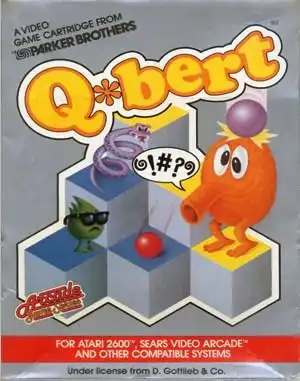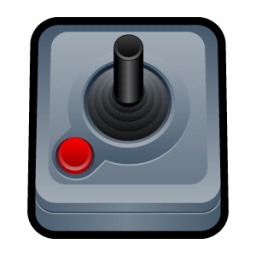Remember the satisfying boing sound and the frustration of !@#?@! when a purple snake got you? If so, you've likely crossed paths with Q*bert, one of the most distinctive and memorable characters to bounce out of the golden age of arcades. This little orange guy, hopping across a pyramid of cubes, captured the hearts (and coins) of gamers back in 1982, offering a unique blend of action and puzzle-solving unlike anything else.
Let's take a hop down memory lane and explore what made Q*bert such an enduring classic.
Stepping Onto the Pyramid: The Unique Gameplay of Q*bert
At its core, the Q*bert game is deceptively simple. Your goal is to change the color of every cube on the isometric pyramid by hopping onto it. Sounds easy, right? Not so fast! The pyramid is a busy place, and you're not alone.
- The Controls: One of the most unique aspects was the diagonally mounted joystick. Pushing up-left moved Q*bert up-left on the screen, and so on. It took a little getting used to, but once you clicked, it felt perfectly intuitive for navigating the 3D-ish space.
- The Enemies: The pyramid is full of hazards:
- Coily: The infamous purple snake, starting as an egg and relentlessly chasing Q*bert. Your main nemesis!
- Ugg and Wrongway: These purple creatures hop along the sides of the pyramid in an M.C. Escher-style, adding another layer of danger.
- Slick and Sam: The green mischief-makers who follow Q*bert and revert the cubes back to their original color, undoing your progress.
- Helpful Objects: Not everything is out to get you. Green balls temporarily freeze enemies, and floating multicolored discs offer a quick escape to the top of the pyramid – perfect for tricking Coily into taking a fatal plunge!
Successfully changing all the cubes' colors completes a stage, leading you to tougher challenges with different color patterns, faster enemies, and even cubes that require multiple hops to change or change color with every jump.
Behind the Bounces: The Making of a Classic
Q*bert was developed by Gottlieb, a company primarily known for pinball machines, which makes its arcade success even more remarkable. The game was largely the brainchild of programmer Warren Davis and artist Jeff Lee.
Lee is credited with the initial concept, inspired by an Escher drawing, and designing the iconic character – originally armless and orange. Davis took these ideas and, aiming for a simple, one-handed control scheme, developed the core hopping and avoidance gameplay. The diagonal joystick was a deliberate choice to match the on-screen movement, despite some initial internal skepticism.
Perhaps the most distinctive element of the game is its sound. Qbert's famous "swearing" sound effect, represented by the !@#?@! grawlix bubble, wasn't originally intended to be speech. Audio engineer David Thiel struggled to synthesize clear English phrases with the Votrax chip and instead opted for random phonemes, which perfectly captured the character's frustration when colliding with an enemy. The title itself went through iterations, from "Cubes" to a brief, impractical stint as "@!#?@!" before landing on the memorable "Qbert" (the asterisk, Davis later noted, caused some unexpected issues!).
From Arcades to Living Rooms: Q*bert's Many Ports
Following its massive success in arcades (selling around 25,000 cabinets), Q*bert quickly made the leap to home consoles and computers. Parker Brothers acquired the home license, leading to ports on nearly every major platform of the era by 1984, including:
- Atari 2600 & 5200
- Intellivision
- ColecoVision
- Commodore 64 & VIC-20
- Atari 8-bit computers
- TI-99/4A
- And later, NES and others.
As was common in that era, the quality of these ports varied wildly. The ColecoVision version was often praised for its accuracy, while the Atari 2600 and Intellivision ports sometimes suffered from technical limitations or awkward controls compared to the arcade original. Despite the inconsistencies, these home versions allowed a whole new audience to experience the hopping madness.
Beyond the Cubes: Legacy, Sequels, and Pop Culture
Q*bert wasn't just a hit game; it became a bona fide pop culture icon of the 1980s.
- Merchandising: The character's appeal led to a wave of merchandise, from toys and board games to lunchboxes and sleeping bags.
- Sequels & Remakes: While none reached the original's legendary status, Gottlieb and later Sony released sequels like Qbert's Qubes*, Qbert 3* (SNES), and modern remakes like Qbert Rebooted*, which brought the classic gameplay to modern platforms with updated graphics and new modes.
- Other Media: Q*bert starred in a segment of the Saturday Supercade cartoon show and has made memorable cameos in films like Wreck-It Ralph and Pixels, cementing his place in animated and cinematic history. High score competitions for the original arcade game continue to this day, with players pushing the limits of endurance and skill on the pyramid.
Interestingly, Q*bert creator Warren Davis once shared a quirky anecdote linking the game's pyramid design to his fondness for White Castle hamburgers. Working long hours near a White Castle, he speculated that stacking the empty burger boxes might have subconsciously influenced the game's iconic playfield structure. A fun, unique peek into the mind behind the classic!
Why We Still Hop: Q*bert's Enduring Charm
Decades later, why does Q*bert still resonate with retro gamers?
- Simple Concept, Deep Challenge: Easy to understand, difficult to master. The escalating difficulty keeps you coming back for one more try.
- Iconic Character: Q*bert himself is instantly recognizable and lovable, despite (or perhaps because of) his limited vocabulary.
- Unique Presentation: The isometric view, the hopping, the sound effects – it all adds up to a game with a distinct personality that hasn't been truly replicated.
- Pure Nostalgia: For many, playing
Q*bertinstantly transports them back to arcades or living rooms of the early 80s.
Whether you first encountered him in a smoky arcade, on a clunky home console, or through a modern remake, Q*bert remains a charming, challenging, and utterly unique piece of video game history. So next time you see that orange guy and his pyramid, maybe give a little hop for old time's sake!
Frequently Asked Questions
Q: Who created the original Q*bert game?
A: The original Q*bert arcade game was created by programmer Warren Davis and artist Jeff Lee at Gottlieb.
Q: Why does Q*bert say "!@#?@!"? A: The iconic "swearing" sound effect was a result of audio engineer David Thiel using random phonemes from a speech synthesizer when he couldn't get clear English phrases to work. It perfectly captured the character's frustration.
Q: Can I play Q*bert today? A: Yes! You can find the original arcade version available through emulation (like MAME) or official retro game collections. The modern remake, Qbert Rebooted*, is also available on platforms like Steam, PlayStation, Xbox, and mobile, offering both the classic and updated gameplay.
Q: What are the main enemies in Q*bert? A: The main enemies are Coily the snake, Ugg and Wrongway who hop along the sides, and Slick and Sam who undo your progress by changing cube colors back.


